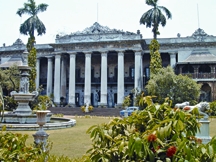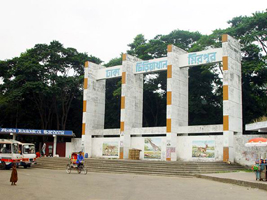Zoological Garden
Zoological Garden (chidyakhana) public or private park where living animals are kept for exhibition, recreation and study. The menageries and aviaries of China, Egypt, and Rome were famous in ancient times. From the late medieval period many rulers had private menageries, some of which later formed the nucleus of public exhibits. Nearly all-large cities now have zoological reserves. Modern trends include breeding threatened animals in captivity, exhibiting animals in enclosures simulating their natural habitat rather than in cages (open-range zones or safari parks), and educating the public about principles of ecology.
In Bengal in the early 19th century, starting from 1801 there were four well-documented institutions in Calcutta, which could be called menageries or even zoos and a host of hearsay private collections.
The rich forests of Northeast India, Burma (now Myanmar) and other border countries, and the state of Bengal itself has its own rich forests to supply a very great diversity of animal life. Calcutta also was a gateway or seaport to the rest of southern Asia (even South India and Sri Lanka) and South East Asia which guaranteed a steady flow of animal life into Calcutta. These factors alone are sufficient to account for the phenomenon that four early and most interesting zoos or menageries originated in Calcutta. They were: 1. Barrackpore Menagerie, founded c 1801 and closed c 1879; 2. Wazir Ali Shah's menagerie founded c 1830's and wound up c 1880; 3. Marble Palace Zoo, founded 1854 and continuing but in decline; and 4. Alipore Zoo, founded in 1875, continuing and renovating.

The Marble Palace Zoo (1854 to present) Rajah Rajendro Mullick Bahadur founded the Marble Palace Zoo in Chorebagan, Calcutta in 1854, and it still stands today in the centre of Kolkata city. The Rajah consciously and intentionally founded it as a public service for education and entertainment of the public. Rajah Rajendro Mullick was a student of natural history and the menagerie in his house contained birds and mammals collected from different parts of the world as well as India. The zoo had important (animal) collections, even before opening to the public. Mullick gave numerous animals to other institutions such as London Zoo. He also gave the Calcutta Zoo valuable animals and was honoured by having the first animal house named after him. Persons who admired and cared deeply about the dramatic and beautiful interesting creatures from around the globe nurtured Marble Palace Zoo. Much thought went into the keeping and display. The first cage ever to be constructed in the Marble Palace Zoo still stands, today holding rabbits and guinea pigs. Even the travelling cages of early days are still there.
Alipore Zoological Garden (1875 to the present) Although Barrackpore Menagerie continued, there were people even as early as 1841, who felt that Calcutta should have a proper zoo. The July 1841 issue of the Calcutta Journal of Natural History relates a proposal by Mr. Raleigh for the establishment of a Zoological Garden. In February 1873, Mr. L Schwendier, a member of the Council of the Asiatic Society of Bengal, detailed the scheme for the establishment of the Zoological Garden. The Society and the Agri-Horticultural Society approved his suggestions. The principal features of the original scheme were: (i) to provide recreation, instruction and amusement for all classes of the community; (ii) to facilitate scientific observations of the habits of animals, more especially those peculiar to tropical countries; (iii) to encourage the acclimatization, domestication, and breeding of animals and to improve the indigenous breed of cattle and farm stock; and (iv) to promote the science of Zoology by the interchange, import and export of animals.

An area of about 14 ha of land was allotted at Alipore by the Government of Bengal and development work started at the instance of Sir Richard Temple, the then Lt. Governor of Bengal. Mr. Schwendler readily donated his fine collection of specimens, and by December 1875 a sizeable menagerie was established with the spontaneous contributions from a number of donors. Raja Surjakanta Acharya Chaudhury of Mymensingh, and the Nawab Abdul Gani and Khajah Ahsanullah Khan Bahadur of Dacca were among the donors. King Emperor Edward VII, the then Prince of Wales, drove through the Garden on his way to Belvedere on the afternoon of 27 December, 1875 in the presence of the elite of Calcutta and inaugurated the zoo formally on the 1st of January, 1875. However, the zoo was made open to the public on the 1st of May 1876. Two young elephants and a leopard were sent to the Garden as a token of interest evinced by His Royal Highness who consented to be the patron of the garden. Ever since the starting of the zoo, the management of the Garden has been vested in an honorary committee appointed by the Government. At present the garden is run under the Alipore Zoological Garden (Management) Rules 1957 framed under the Bengal Public Parks Act, 1904 and the Managing Committee consists of 22 members (of which 10 are ex-officio members), nominated by the State Government.
Twenty thousand visitors a day is not unusual, and on special days the count reaches 100,000. The first attempt of modernisation of the zoo was made in 1957 when the authorities of the zoo constructed an open-air enclosure for tigers. The construction and opening of a freshwater aquarium in l977 added a new dimension to the Alipore Zoo. It was the first significant addition to the zoo after its centenary. It is one of the largest freshwater aquarium in the Eastern India having 17 large and 48 small tanks. It has now about 1500 freshwater fishes belonging to different species both exotic and indigenous.
A spacious (1064 sq m) new reptile house was established in 1979 for better housing and display of different reptiles. It has 48 exhibition cages arranged in circular fashion for display of different species of reptiles and a big central pool with a canopy of dome shaped wire netted roof for exhibition of crocodiles and gharials. The construction of new small carnivora house in 1981 with twelve large cages has provided a good opportunity for better exhibition and breeding of jaguar and other carnivores. An open air enclosure for bears having six dens have been constructed in 1985. An open-air enclosure for elephants was constructed in 1999. The most significant and striking achievement of Alipore Zoological Garden is the breeding of giraffe in 1988. The zoo is still holding a Giant Tortoise in its collection since 1875.
Principally the gate receipts, supplemented by annual grants received from the State Government maintain the garden. The garden, as it stands today stretches over 16 hectares of land with its charming layout of lawns, flower beds, lakes, bridges, avenues, animal houses, aviaries, waterways, plants, and shrubbery. [Md Anwarul Islam]
Dhaka Zoo the largest zoo in Bangladesh, situated at Mirpur about 16 km from the centre of Dhaka city. It is the national zoo under the Ministry of Fisheries and Livestock, started as a menagerie at the High Court Premises in Dhaka in 1964, and moved to its present location in 1974. In the same year it was ceremonially opened for public on June 23. The zoo occupies an area of about 75 ha. It has two lakes of about 13 ha, which receive thousands of waterfowls every year in winter.

The total number of vertebrate fauna in the zoo is about 2,150 in 191 species. Included in these animals, are about 551 mammals under 64 species, 1,543 birds under 90 species, 73 reptiles under 15 species, and about 104 aquarium fishes under 23 species. To attract visitors besides many fascinating animals, there are 15 tigers, 21 lions, 9 hippopotamus, about 200 monkeys, and 33 pythons. Moreover, some rare and interesting animals such as the rhea, peacock, zebra, elephant, African grey parrot, water buck, impala, emu, baboon, chimpanzee, gayal, black bear, tapir, mandrill, and estuarine crocodile provide additional entertainment to the visitors.
The zoo has a captive breeding programme and successfully bred the Royal Bengal Tiger, lion, leopard, primates, deer, and many birds. It has animal exchange programmes with many zoos of the world. As gifts Bangladesh government presented about 300 zoo animals to different organisations and personalities of different countries including Saudi Arabia, Kuwait, Bahrain, and Iraq. The zoo regularly organizes various education programmes for students. The various ornamental features of the garden provides an aesthetic background to the animal houses, enclosures and aviaries, scattered all over the area, exhibiting indigenous fauna of Bangladesh as well as exotic specimens collected from different countries of the world.
About 3 million visitors visit the Dhaka Zoo every year. Except Sunday the zoo remains open on other weekdays from 8:00 am to 5:00 pm (October-March) and from 8:00 am to 6:00 pm (April-September). It also remains opens to the visitors for certain hours during government holidays. The beautiful natural environments of the zoo offer almost all recreational facilities to the visitors, a large part of which is constituted by the students and children. The zoo has an advisory committee headed by the Minister, Ministry of Fisheries and Livestock.
Outside Dhaka there are 5 more zoos in the towns of Rangpur, Chittagong, Rajshahi, Comilla, and Khulna. The Ministry of Fisheries and Livestock runs the Rangpur Zoo, and the Khulna Zoo is looked after by armed forces. Local government authorities run the other 3 zoos. [M Shahidullah]
